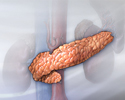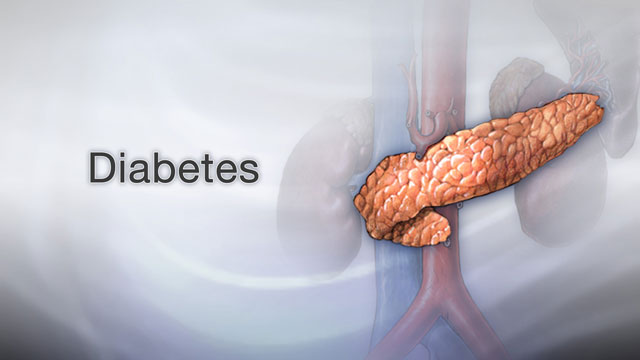Scleredema diabeticorum
Scleredema of Buschke; Scleredema adultorum; Diabetic thick skin; Scleredema; Diabetes - scleredema; Diabetic - scleredema; Diabetic dermopathy
Scleredema diabeticorum is a skin condition that occurs in some people with diabetes. It causes skin to become thick and hard on the back of the neck, shoulders, arms, and upper back.
Causes
Scleredema diabeticorum is thought to be a rare disorder, but some people think that the diagnosis is often missed. The exact cause is unknown. The condition tends to occur in men with poorly-controlled diabetes who:
- Are obese
- Use insulin
- Have poor blood sugar control
- Have other diabetes complications
Symptoms
Skin changes happen slowly. Over time, you may notice:
- Thick, hard skin that feels smooth. You cannot pinch the skin over the upper back or neck.
- Reddish, painless lesions.
- Lesions occur on the same areas on both sides of the body (symmetrical).
In severe cases, thickened skin can make it hard to move the upper body. It also can make deep breathing difficult.
Some people find it hard to make a clenched fist because the skin on the back of the hand is too tight.
Exams and Tests
Your health care provider will perform a physical exam. You will be asked about your medical history and symptoms.
Tests may include:
- Fasting blood sugar
- Glucose tolerance test
- Hemoglobin A1C test
- Skin biopsy
Treatment
There is no specific treatment for scleredema. Treatments may include:
- Improved control of blood sugar (this may not improve the lesions once they have developed)
- Phototherapy, a procedure in which the skin is carefully exposed to ultraviolet light
- Glucocorticoid medications (topical or oral)
- Electron beam therapy (a type of radiation therapy)
- Medicines that suppress the immune system
- Physical therapy, if you find it hard to move your torso or breathe deeply
Outlook (Prognosis)
The condition cannot be cured. Treatment may improve movement and breathing.
When to Contact a Medical Professional
Contact your provider if you:
- Have trouble controlling your blood sugar
- Notice symptoms of scleredema
If you have scleredema, contact your provider if you:
- Find it hard to move your arms, shoulders, and torso, or hands
- Have trouble breathing deeply due to tight skin
Prevention
Keeping blood sugar levels within a healthy range helps prevent diabetes complications. However, scleredema can occur, even when blood sugar is well controlled.
Your provider may discuss adding medicines that allow insulin to work better in your body so that your insulin doses can be reduced.
References
Flischel AE, Helms SE, Brodell RT. Scleredema. In: Lebwohl MG, Heymann WR, Coulson IH, Murrell DF, eds. Treatment of Skin Disease: Comprehensive Therapeutic Strategies. 6th ed. Philadelphia, PA: Elsevier; 2022:chap 223.
James WD, Elston DM, Treat JR, Rosenbach MA, Neuhaus IM. Mucinoses. In: James WD, Elston DM, Treat JR, Rosenbach MA, Neuhaus IM, eds. Andrews' Diseases of the Skin: Clinical Dermatology. 13th ed. Philadelphia, PA: Elsevier; 2020:chap 9.
Patterson JW. Cutaneous mucinoses. In: Patterson JW, ed. Weedon's Skin Pathology. 5th ed. Philadelphia, PA: Elsevier Limited; 2021:chap 14.
Rongioletti F. Mucinoses. In: Bolognia JL, Schaffer JV, Cerroni L, eds. Dermatology. 4th ed. Philadelphia, PA: Elsevier; 2018:chap 46.
Simms RW. Localized scleroderma and scleroderma-like syndromes. In: Hochberg MC, Gravallese EM, Smolen JS, van der Heijde D, Weinblatt ME, Weisman MH, eds. Rheumatology. 8th ed. Philadelphia, PA: Elsevier; 2023:chap 155.
Review Date: 6/7/2023







